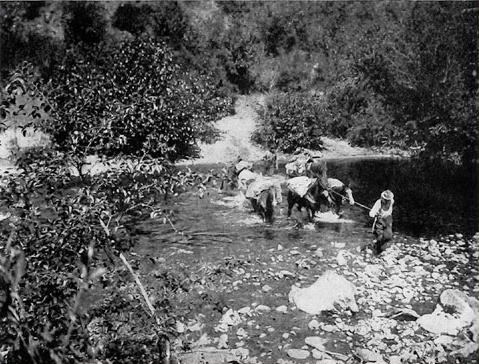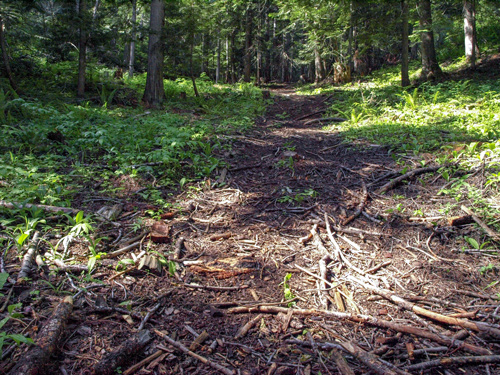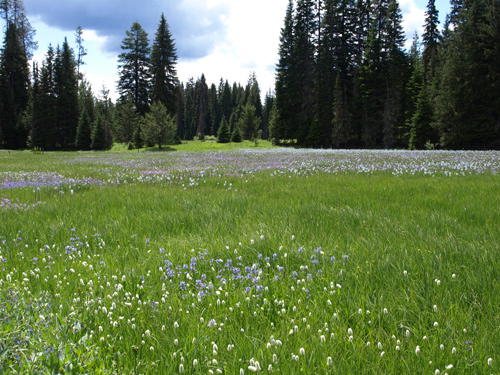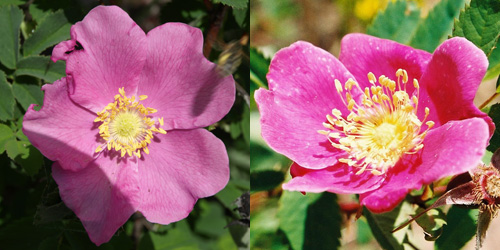After a nearly 6-week stay at Long Camp waiting for mountain snows to melt, the horses are loaded, and the expedition climbs the valley hills, fords Lolo Creek, and then climbs up to the “quawmash flatts”—Weippe Prairie, Idaho. Lewis notices the fertile country, two species of wild roses, and collects specimens of buckbrush ceanothus and bluebunch wheatgrass. At camp, he taste-tests Columbian ground squirrel.
Ford on Lolo (Collins) Creek
Olin D. Wheeler, The Trail of Lewis and Clark. See also Wheeler’s “Trail of Lewis and Clark”.
Fording Lolo (Collins) Creek
we ascended the river hills which are very high . . . . the pass of Collins‘s Creek was deep and extreemly difficult tho’ we passed without sustaining further injury than weting some of our roots and bread.
—Meriwether Lewis
Image: A packer and his partner coax a six-animal pack string through the Lolo (Collins) Creek ford on the trail between the Clearwater Canyon and Weippe Prairie. Judging from Lewis’s comment, it seems quite likely that the creek was considerably deeper and faster than this in early June, and the horses would have had to swim it with their riders aboard. In June, the rocks in the foreground would certainly have been under water. With sixty-five horses to get across, it is a testament to the skill of the riders and packers that they all made it without an accident.
Nez Perce Trail between Kamiah and Weippe, Idaho
© 7 June 2009 by Kristopher K. Townsend. Permission to use granted under the Creative Commons Attribution-Share Alike 4.0 International license.
Above: The steep trail is just above the Lolo Creek crossing looking back towards Kamiah. See also The Northern Nez Perce Trail.
Fertile Country
the country through which we passed is extreemly fertile and generally free of stone, is well timbered with several speceis of fir, long leafed pine and larch.
—Meriwether Lewis
Numerous Squirrels
we find a great number of burrowing squirrels [Columbian ground squirrels] about our camp of which we killed several; I eat of them and found them quite as tender and well flavored as our grey squirel.
—Meriwether Lewis
Camas Blooms, Weippe Prairie
© 7 June 2009 by Kristopher K. Townsend. Permission to use granted under the Creative Commons Attribution-Share Alike 4.0 International license.
The “quawmash flatts”
The com-mas [Camas] grows in great abundance on this plain [Weippe Prairie]; and at this time looks beautiful, being in full bloom with flowers of a pale blue colour.
—Patrick Gass
Two Wild Roses
there are two speceis of the wild rose both quinqui petallous and of a damask red but the one is as large as the common red rose of our gardens.
—Meriwether Lewis
Buckbrush ceanothus
An Evergreen A Shrub about 8 or 9 f. high. On the Rocky mountains waters of the Kooskooskee [Clearwater River]
—Meriwether Lewis[1]Ceanothus velutinus. Moulton, ed. Herbarium, specimen 37.
Bluebunch Wheatgrass
On the plains of Columbia Jun: 10th 1806.
—Meriwether Lewis[2]Pseudoroegneria spicata. Moulton, ed. Herbarium, specimen 133.
Weather Diary
State of the weather at rise
Wind at rise
State of the weather at 4 P.M. Wind at 4 P.M. fair S E fair N W —Meriwether Lewis[3]To assist the reader of this web page, the date column is not presented and some abbreviations have been spelled out.
Experience the Lewis and Clark Trail
The Lewis and Clark Trail Experience—our sister site at lewisandclark.travel—connects the world to people and places on the Lewis and Clark Trail.
Plan a trip related to June 10, 1806:

Weippe Prairie is a High Potential Historic Site along the Lewis and Clark National Historic Trail managed by the U.S. National Park Service. A 274-acre tract in the prairie is managed by the Nez Perce National Historic Park.






